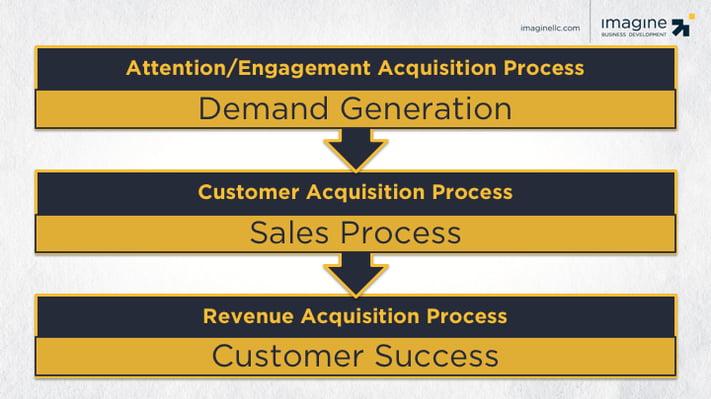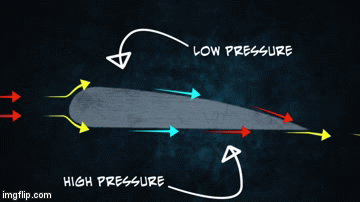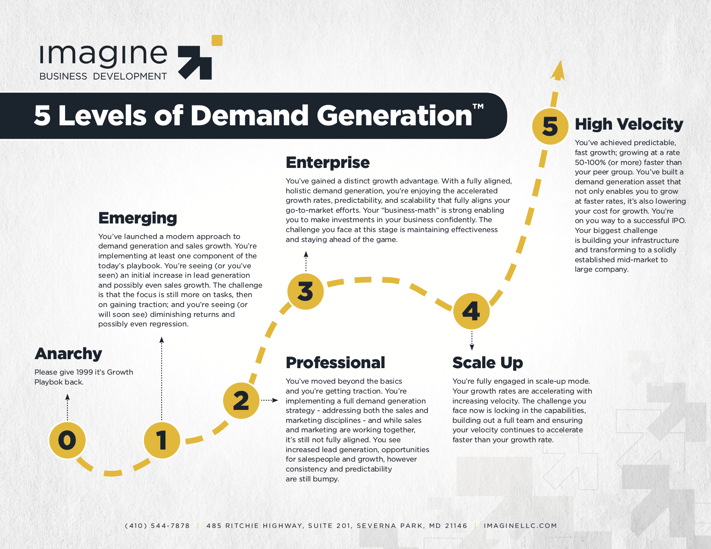Over the last 15 years, my company has extensively studied organizations that are consistently growing at rates of 50, 100, 200, even 300% their industry's averages. What are the key things that these companies are doing that enable them to grow in such a way that they outpace their competition? It's like they've figured out a secret, and that's the focus of what I want to share with you today, the secret to fast growth.
Now, I’ve got good news for you — the secret's nothing particularly mysterious. It comes down to science, but before I get to the secret, let me start by setting some expectations. The first thing that you need to figure out is what level game do you want to play out, what level of demand generation do you want to perform? We've identified five levels that we refer to as the modern playbook. For the purposes of this conversation, there's really only three levels that you should be focused on: level one, three or five.
The Five Levels of Demand Generation
Level one is basically doing just some of the key elements around demand generation, content and lead generation. It's not going to give you an advantage or anything, since you’re just doing some of the key things that you simply have to do in today's world to be able to compete effectively, attract customers and keep them.
Level three is where most fast-growth companies are going to find themselves. They need to have excellent, enterprise-level, demand-generation capabilities.
Level five, that's for the fast-growth unicorns out there. If you want to knock the cover off the ball, be the next HubSpot, be the next latest, greatest company out there, — that’s what level five is about. Levels two and four are really just pathways to get to level three and level five. If you want to play at level three or level five, what I'm going to be sharing with you is absolutely key to success.
The Traditional Approach to Growing Revenue
Now, let's take a step back and think about our approach to growth. How do we focus on growing our company? What are the strategies, tactics and efforts that we put forth? I want you to think about that for a moment. Think about the last five years. So, it's 2018. Think about how hard you had to work in 2013, then how hard you needed to work in 2014, 2015, 2016, 2017, and so far, this year.
My bet is it's going to feel kind of like this - a lot of heavy lifting. However, what's interesting is, when you study the keys that drive the type of fast growth that you can expect at level three or level five, you don't have that heavy lifting. Don't get me wrong. It's hard work. Growing fast is hard, but you build momentum that propels you to faster growth.
It's a lot easier to maintain growth than to get it, but what you're going to see is that the way we're growing companies today, the way that we’re approaching it, we really are on the treadmill of life. We have to work a little bit harder every year. We have to run a little bit faster every year just to be able to maintain the pace.
The Three Acquisition Processes Every Growth Business Must Master
So, how can we change the game? How can we make it easier to achieve our long-term objectives and get on that fast-growth glide path? Understand, the key to fast growth is really built around customer acquisition and ultimately customer retention.

When we think about our customer acquisition strategy, we have to understand that there are really three acquisition processes that we're implementing, and each process limits the capacity and the ability of the next process in terms of what it can produce. So, if we think about the first process, it's all about generating the attention and engagement of people that we want to do business with. The attention and engagement of what I like to call the right-fit customer's or the right-fit leads.
That's what demand generation is all about. Gain attention and engagement then connect to our customer acquisition process. Acquiring customers is what the sales process is designed to do. Then that sales process transfers to the revenue acquisition process which is what customer success is all about.
We often conflate these three processes into one, but they really are three distinct processes. If you want to accelerate revenue growth, you have to accelerate customer acquisition. Certainly, you can get more revenue by generating increased revenue from your existing customer base. But regardless of what your pricing strategies or upsell strategies are, your revenue generation capability is limited by your customer acquisition capability.
Want to increase total revenue? Increase the number of customers that you can create. The number of customers that you can create is limited by your demand generation process. How much attention and engagement is there? Our demand generation or attention and engagement acquisition process create a limiting barrier to what we can do on the customer acquisition side, which creates a limiting barrier to what we're going to be able to do with the revenue acquisition phase. Want to increase your production capacity? Increase the capacity of the process that occurs previously.
The Secret to Fast Growth - The Principle of Lift
This leads us to the secret of fast growth, which might surprise you. It surprises a lot of people when I talk to them about it because the secret of fast growth comes from physics. If you've ever been on a plane before, and you've ever stopped and wondered how does this big gigantic thing get in the air and fly across the sky the way it does. Here’s the answer — it's a physics principle called lift.
The principle of lift is what enables a plane to fly. It's what enables a plane to get in the air and stay up at altitude to get you across the country faster than just about any other normal means of transportation. How does lift work? It's actually a relatively simple process. The principle basically says, if the rate of wind, if the velocity or airspeed above the wing is faster than the velocity or airspeed below the wing, a vacuum is created. You get a low-pressure system above the wing, a high-pressure system below the wing, and the plane is literally sucked up into the air. It's lifted into the air.

Now, think about how you generate revenue. The same principle applies. If you want to generate revenue at faster rates, without exhausting everybody in your organization, you need to generate lift. The velocity of your activities "above the wing" needs to be greater than the velocity of activities "below the wing," or you'll constantly be fighting gravity.
This is the purpose of demand generation. This is why the focus needs to be on the top of the funnel. Yes, you need to have strong bottom-of-funnel processes that turn interest, engagement and attention into revenue, but if you are not generating real engagement, real interest at a velocity significantly faster than the rate you want to grow, then you are limiting your ability to grow. And if you don't have lift working for you and you want to take off, the only thing you can use is propulsion, like a rocket that doesn't take advantage of the principle of lift. It just looks to kind of blow up into the sky as fast as possible, and that's really one of the major reasons that we're having the problems in business today that we're having.
We're spending so much time focused down around sales, qualified leads, opportunities and generating customers that really the rate of wind below the wing is faster than the rate of the wind above the proverbial wing. We're adding to the gravitational pull, making it harder for us to grow.
You know, really, at the end of the day, it's not that complicated. This is what you have to do to grow your business. Are you generating awareness and engagement at a higher rate than you're generating quality leads? Are you generating quality leads at a higher rate in velocity than you're generating quality conversations? Are you generating quality conversations at a higher rate than quality sales opportunities?
If you do that and manage your sales process effectively, you'll see increased win rates, you'll scale growth, and growth becomes far more predictable, far more sustainable, far more scalable, and believe it or not, it begins to become effortless. I hope you enjoyed this presentation and this post. If you found it interesting and you want to hear more insights like this, I encourage you, join us on the next edition of The Black Line Podcast.

